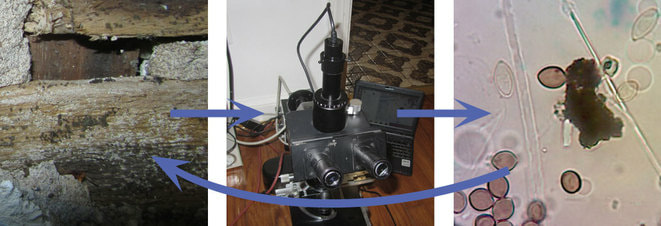Immediate results
Most companies performing mold inspections can perform only visual examination and moisture measurements while in the building. They have to send their samples to environmental laboratories in order to receive the answer whether or not something they expected to be mold is actually mold and what type of mold it is. Usually it takes at least a couple of days for inspectors to get the results from a laboratory. Although most laboratories do offer quick turn-around time for analysis, it is still not less than 3 hours and prices for rush tests are really high. Add here time for delivery of the samples to the laboratories. In any case, the inspectors would not on-site by the time they get the answer.
These inspectors do have certain training in mold, some are even quite knowledgeable due to experience but they are rarely professional mycologists who know details on habits and health effects of different fungal species.
In our case, initial microscopy is done on-site (in situ) by a PhD mycologist with 17 years of experience in fungal systematics and ecology.
How does it make the inspection better?
Most likely your first thought would be that the client gets the answer right at the moment. True, it is nice but not crucial. In most cases, mold problems are long term hassles rather than extreme emergencies and, by the time of the inspection, the client probably already took a few weeks thinking whether or not the house needs to be checked for mold. Three extra days do not really make a big difference for practical matter. It is much more important that finding mold spores in one spot is a hint for the inspector on where to dig further. It helps to see the whole picture right there and right at the moment. This way, the inspector gets a better idea on where the mold could be and not yet found.
Listening and education
While many inspectors just do their work trying to avoid distraction by their clients and therefore preferring clients not to be around, we do the opposite. We want them to be there. We will listen to all their worries, suspicions and fears and answer all the questions. They could be odd sometimes but it is OK - we are here to explain science in lay language. We will help to find the best solution to the problem as it is in this specific house. We will teach the clients everything they need and want to know about mold. Client can see microscopic mold structures on a laptop screen in real time through a camera attached to a microscope or right in the microscope.
Most companies performing mold inspections can perform only visual examination and moisture measurements while in the building. They have to send their samples to environmental laboratories in order to receive the answer whether or not something they expected to be mold is actually mold and what type of mold it is. Usually it takes at least a couple of days for inspectors to get the results from a laboratory. Although most laboratories do offer quick turn-around time for analysis, it is still not less than 3 hours and prices for rush tests are really high. Add here time for delivery of the samples to the laboratories. In any case, the inspectors would not on-site by the time they get the answer.
These inspectors do have certain training in mold, some are even quite knowledgeable due to experience but they are rarely professional mycologists who know details on habits and health effects of different fungal species.
In our case, initial microscopy is done on-site (in situ) by a PhD mycologist with 17 years of experience in fungal systematics and ecology.
How does it make the inspection better?
Most likely your first thought would be that the client gets the answer right at the moment. True, it is nice but not crucial. In most cases, mold problems are long term hassles rather than extreme emergencies and, by the time of the inspection, the client probably already took a few weeks thinking whether or not the house needs to be checked for mold. Three extra days do not really make a big difference for practical matter. It is much more important that finding mold spores in one spot is a hint for the inspector on where to dig further. It helps to see the whole picture right there and right at the moment. This way, the inspector gets a better idea on where the mold could be and not yet found.
Listening and education
While many inspectors just do their work trying to avoid distraction by their clients and therefore preferring clients not to be around, we do the opposite. We want them to be there. We will listen to all their worries, suspicions and fears and answer all the questions. They could be odd sometimes but it is OK - we are here to explain science in lay language. We will help to find the best solution to the problem as it is in this specific house. We will teach the clients everything they need and want to know about mold. Client can see microscopic mold structures on a laptop screen in real time through a camera attached to a microscope or right in the microscope.

